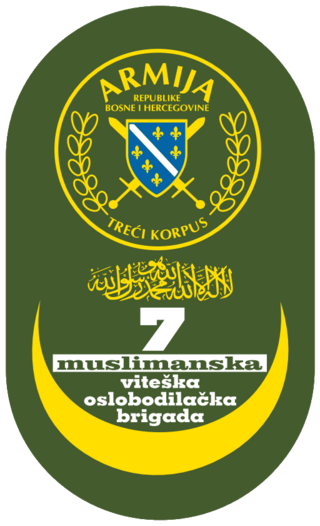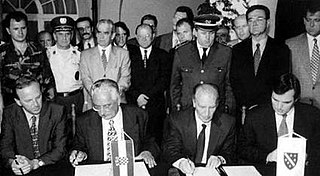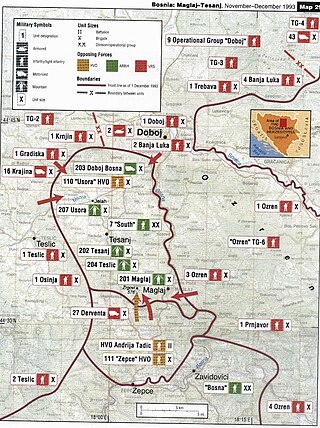Related Research Articles

The Bosnian War was an international armed conflict that took place in Bosnia and Herzegovina between 1992 and 1995. The war is commonly seen as having started on 6 April 1992, following a number of earlier violent incidents. The war ended on 14 December 1995 when the Dayton accords were signed. The main belligerents were the forces of the Republic of Bosnia and Herzegovina, the Republic of Herzeg-Bosnia, and the Republika Srpska, the latter two entities being proto-states led and supplied by Croatia and Serbia, respectively.

The Army of the Republic of Bosnia and Herzegovina, often referred to as Bosnian Army or Bosniak Army, was the military force of the Republic of Bosnia and Herzegovina. It was established by the government of the Republic of Bosnia and Herzegovina in 1992 following the outbreak of the Bosnian War.

The 7th Muslim brigade was an elite all-volunteer brigade of the 3rd Corps of the Army of the Republic of Bosnia and Herzegovina. It served as the ARBiH's primary assault brigade in Central Bosnia, and was headquartered in Zenica. The brigade's manpower largely came from the cities of Zenica, Travnik, and Kakanj; however, there were soldiers from all over Bosnia who served in its ranks. During the war, the brigade liberated over 1,100 km2 of territory, including multiple cities, as well as numerous villages and mountains. Some of the most notable combat actions of the 7th Muslim brigade include the liberation of Vareš, Fojnica, Bugojno, Kakanj, and Travnik from the hands of HVO forces, as well as the defence of Mt. Igman and the liberation of liberation of Mt. Vlašić (Opaljenik), Teslić-Šerić (Jezera), Nabožić (Ilijaš), and Vozuća and the Ozren pocket from VRS forces.

The Croat–Bosniak War was a conflict between the Republic of Bosnia and Herzegovina and the Republic of Herzeg-Bosnia, supported by Croatia, that lasted from 18 October 1992 to 23 February 1994. It is often referred to as a "war within a war" because it was part of the larger Bosnian War. In the beginning, the Army of the Republic of Bosnia and Herzegovina and the Croatian Defence Council (HVO) fought together in an alliance against the Yugoslav People's Army (JNA) and the Army of Republika Srpska (VRS). By the end of 1992, however, tensions between Bosniaks and Bosnian Croats increased. The first armed incidents between them occurred in October 1992 in central Bosnia. The military alliance continued until early 1993, when it mostly fell apart and the two former allies engaged in open conflict.

Rasim Delić was the chief of staff of the Bosnian Army. He was a career officer in the Yugoslav Army but left it during the breakup of Yugoslavia and was convicted of war crimes by the International Criminal Tribunal for the former Yugoslavia for failing to prevent and punish crimes committed by the El Mujahid unit under his command. He was sentenced to 3 years in prison.
Bosnian mujahideen, also called El Mudžahid, were foreign Muslim volunteers who fought on the Bosnian Muslim side during the 1992–95 Bosnian War. They first arrived in central Bosnia in the latter half of 1992 with the aim of helping their Bosnian Muslim co-religionists in fights against Serb and Croat forces. Initially they mainly came from Arab countries, later from other Muslim-majority countries. Estimates of their numbers vary from 500 to 6,000.
Mujahideen, or Mujahidin, is the plural form of mujahid, an Arabic term that broadly refers to people who engage in jihad, interpreted in a jurisprudence of Islam as the fight on behalf of God, religion or the community (ummah).
Operation Miracle was a successful attack by the foreign troops of the Bosnian Mujahideen against the village of Krčevine in the Zavidovići municipality on 21 July 1995.
Operation Corridor 92 was the largest operation conducted during the Bosnian War by the Army of Republika Srpska (VRS) against the forces of the Croatian Defence Council (HVO) and the Croatian Army (HV) in the Bosanska Posavina region of northern Bosnia and Herzegovina between 24 June and 6 October 1992. The objective of the offensive was to re-establish a road link between the city of Banja Luka in the west of the country and the eastern parts of the territory controlled by the Bosnian Serbs. The offensive was prompted by the capture of Derventa by the HV and the HVO – a move that blocked the single overland road between the VRS-controlled territories.
Operation Vrbas '92 was a military offensive undertaken by the Army of Republika Srpska in June–October 1992, during the Bosnian War. The goal of the operation was the destruction of a salient around the central Bosnian town of Jajce, which was held by the Croatian Defence Council and the Army of the Republic of Bosnia and Herzegovina. The intensity of fighting varied considerably and involved several major VRS offensive efforts interspersed by relative lulls in fighting. Jajce fell to the VRS on 29 October 1992, and the town's capture was followed by the destruction of all its mosques and Roman Catholic churches.

The Croat–Bosniak War was a conflict between the Republic of Bosnia and Herzegovina and the Croatian Community of Herzeg-Bosnia, supported by Croatia, that lasted from 19 June 1992 – 23 February 1994. The Croat-Bosniak War is often referred to as a "war within a war" because it was part of the larger Bosnian War.

The Siege of Mostar was fought during the Bosnian War first in 1992 and then again later in 1993 to 1994. Initially lasting between April 1992 and June 1992, it involved the Croatian Defence Council (HVO) and the Army of the Republic of Bosnia and Herzegovina (ARBiH) fighting against the Serb-dominated Yugoslav People's Army (JNA) after Bosnia and Herzegovina declared its independence from Yugoslavia. That phase ended in June 1992 after the success of Operation Jackal, launched by the Croatian Army (HV) and HVO. As a result of the first siege around 90,000 residents of Mostar fled and numerous religious buildings, cultural institutions, and bridges were damaged or destroyed.

The Split Agreement or Split Declaration was a mutual defence agreement between Croatia, the Republic of Bosnia and Herzegovina and the Federation of Bosnia and Herzegovina, signed in Split, Croatia on 22 July 1995. It called on the Croatian Army (HV) to intervene militarily in Bosnia and Herzegovina, primarily in relieving the siege of Bihać.
Amir Kubura is a former Bosnian commander of the Army of the Republic of Bosnia and Herzegovina and officer of the Yugoslav People's Army who was indicted by the International Criminal Tribunal for the former Yugoslavia and sentenced to two years imprisonment for 'plunder of public or private property'.
The Battle of Vozuća was an attack by the 3rd Corps of the Army of the Republic of Bosnia and Herzegovina and the foreign troops of the Bosnian mujahideen on 10 September 1995 against the strategically important Army of Republika Srpska-held village of Vozuća, in the municipality of Zavidovići during the Bosnian War.

The Battle of Žepče took place between the Army of the Republic of Bosnia and Herzegovina (ARBiH) and the Croatian Defence Council (HVO) in Žepče, Bosnia and Herzegovina on the 24th of June 1993.
Operation Southern Move was the final Croatian Army (HV) and Croatian Defence Council (HVO) offensive of the Bosnian War. It took place in western Bosnia and Herzegovina on 8–11 October 1995. Its goal was to help the Army of the Republic of Bosnia and Herzegovina (ARBiH) whose positions around the town of Ključ, captured by them during Operation Sana, were endangered by a counteroffensive by the Army of Republika Srpska (VRS). The objectives of Operation Southern Move included the capture of the town of Mrkonjić Grad and positions on the Manjača Mountain which would allow the HV and the HVO to directly threaten Banja Luka, the largest city controlled by Bosnian Serbs. Finally, the offensive was also aimed at capturing the Bočac Hydroelectric Power Station, the last significant source of electricity under VRS control in western Bosnia and Herzegovina. The combined HV and HVO forces were under the overall command of HV Major General Ante Gotovina.

Sakib Mahmuljin is a Bosniak politician and former military leader who served as the commander of the 3rd Corps of the Army of the Republic of Bosnia and Herzegovina (ARBiH) during the Bosnian War. After the war, he was convicted of committing war crimes against Bosnian Serb prisoners and sentenced to eight years' imprisonment.
The Battle of Bugojno was fought between forces of the Army of the Republic of Bosnia and Herzegovina (ARBiH) and the Croatian Defence Council (HVO) for control of the town and municipality of Bugojno in central Bosnia, from 18–28 July 1993. The area of Bugojno was under joint control of the ARBiH 307th Brigade and the HVO Eugen Kvaternik Brigade since the start of the Bosnian War. Violent incidents in Bugojno followed the escalation of the Croat-Bosniak War in adjacent municipalities throughout the 1st half of 1993. Bugojno was spared from fighting and the two local brigades were still formally allied by June 1993, at the time of an ARBiH offensive in central Bosnia.

The Battle of Travnik was a battle between the Croatian Defence Council (HVO) and the Army of the Republic of Bosnia and Herzegovina (ARBiH) to stop Bosniak aggression in the areas of Travnik and the Travnik region inhabited by Croats.
References
- ↑ Cerwyn Moore & Paul Tumelty (2008) Foreign Fighters and the Case of Chechnya: A Critical Assessment, Studies in Conflict & Terrorism, 31:5, 412-433, DOI: 10.1080/10576100801993347
- ↑ "Bosnian Muslim Ex-Commander Jailed 10 Years Over War Crimes by Islamist Fighters". usnews. Retrieved 16 November 2021.
- ↑ Marko Attila Hoare (2 June 2008). "Christopher Deliso, John R. Schindler and Shaul Shay on al-Qaeda in Bosnia". Greater Surbiton. Retrieved 4 February 2019.
Schindler's subject matter is narrower than Deliso's, being confined essentially to Bosnia. It is less a study of the role of al-Qa'ida and the mujahedin in Bosnia and more a diatribe against the Bosnian Muslims and the Bosnian cause. Despite the author's claim to having had a youthful flirtation with Islam, he is clearly hostile to the religion and views the Bosnian war on this basis."; "Deliso's animosity in particular is directed against the Albanians, and he faithfully upholds anti-Albanian stereotypes popular among the Balkan Christian peoples."; "Shay's run-of-the-mill-first-year-undergraduate-quality potted history of the Balkans repeats some of the historical and other factual errors made by Deliso and Schindler, in particular at the expense of the Bosnian Muslims (...) If one simply ignores everything Shay's book has to say about Balkan politics, then one can glean a few nuggets of information from it concerning the politics of radical Islam globally and of the Muslim states of the Middle East. But this is not enough to recommend this book (...)
- 1 2 3 Innes 2006, p. 157.
- 1 2 LA Times, Bosnia Seen as Hospitable Base and Sanctuary for Terrorists, 8 October 2001
- ↑ "Predrag Matvejević: "Slovenski muslimani u Bosni", essay published in EL PAIS". Archived from the original on 2012-12-08.
- ↑ Matvejević, Predrag (13 October 2001). "Los musulmanes eslavos de Bosnia". El País (in Spanish). EL PAIS. Retrieved 4 February 2019.
- ↑ "Humanitarian worker turned Mujahideen". Archived from the original on 2019-02-04. Retrieved 2019-02-04.
- ↑ "ICTY: Mujahideen didn't trust the Army". Sense Agency. Archived from the original on 2018-07-22. Retrieved 2008-03-01.
- ↑ Fisk, Robert (7 September 2014). "After the atrocities committed against Muslims in Bosnia, it is no wonder today's jihadis have set out on the path to war in Syria". The Independent.
- 1 2 3 ICTY: Summary of the judgement for Enver Hadžihasanović and Amir Kubura - "Archived copy" (PDF). Archived from the original (PDF) on 2011-07-28. Retrieved 2010-02-05.
{{cite web}}: CS1 maint: archived copy as title (link) - ↑ Spero News Archived 2006-11-23 at the Wayback Machine , Bosnia: Muslims upset by Wahhabi leaders, Adrian Morgan, 13 November 2006
- ↑ ICTY, Summary of the Judgment for Enver Hadzihasanovic and Amir Kubura, 15 March 2006. See section "VI. The Mujahedin"
- 1 2 "WHY BH ARMY FAILED TO DEAL WITH MUJAHIDEEN - SENSE Agency - News". www.sense-agency.com. SENSE Agency. Archived from the original on 7 February 2019. Retrieved 4 February 2019.
- 1 2 3 "ICTY - TPIY" . Retrieved 5 May 2015.
- ↑ Curtis 2010, p. 207.
- ↑ PBS Newshour with Jim Jim Lehrer Archived 2013-10-02 at the Wayback Machine , A New Constitution for Bosnia, 22 November 2005
- ↑ 9/11 Commission Report, Chapter 5.2, pp. 153–159
- ↑ "BBC News - EUROPE - Mujahideen fight Bosnia evictions" . Retrieved 5 May 2015.
- ↑ "'Brutal crimes' of Bosnia Muslims". BBC News. December 2, 2003.
- ↑ Berger 2011, p. 93.
- ↑ Swicord, Jeff (November 17, 2015). "Seeds of Jihad Planted in the Balkans". Voice of America.
- ↑ Erjavec, Dragana (June 8, 2016). "Bosnia Mujahideen Prisoner 'Forced to Kiss Severed Head'". JusticeReport. BIRN.
- ↑ Urban, Mark (2 July 2015). "Bosnia: Cradle of modern jihad?". BBC. Retrieved 7 February 2019.
Its commander at the time, Brigadier General Enver Hadzihasanovic, ended up facing a war crimes trial in the Hague on charges of overall responsibility for some of the Mujahideen's behaviour, including the Travnik kidnappings. In the end, the prosecution dropped those charges, but the general served two years, having been found guilty of having (Bosnian) troops under him who had abused prisoners.
- ↑ "Hadžihasanović & Kubura Appeals Only Partially Granted". www.icty.org.
- ↑ "Summary of the Judgement for Hadžihasanović and Kubura" (PDF). Archived from the original (PDF) on 2022-01-05. Retrieved 2019-02-04.
- ↑ "ICTY - TPIY" . Retrieved 5 May 2015.
- 1 2 "Press - International Criminal Tribunal for the former Yugoslavia". www.icty.org. ICTY. Retrieved 4 February 2019.
- 1 2 3 "Rasim Delić Sentenced to Three Years for Cruel Treatment". ICTY.org. International Criminal Tribunal for the former Yugoslavia. 15 September 2008.
- ↑ "Bosnia Awards Iraqi War Crimes Convict €36,600". Balkan Insight. 9 November 2016.
- ↑ "FINAL JUDGMENT FOR HADZIHASANOVIC AND KUBURA - SENSE Agency - News". www.sense-agency.com. SENSE Agency. Archived from the original on 7 February 2019. Retrieved 4 February 2019.
- ↑ Dzidic, Denis (January 25, 2016). "Report Probes Mujahideen Killings During Bosnian War". BalkanInsight.com.
- ↑ "Army of BiH commander Mahmuljin sentenced to 10 years in prison for war crime". fena.ba. 22 January 2021.
- 1 2 "Prosecutor v. Milomir Stakic". un.org. 31 July 2003. Archived from the original on 2 October 2008.
- ↑ "STAKIC: CRIMES AND FORCIBLE EXPULSIONS OF PRIJEDOR INHABITANTS ARE A FACT - SENSE Agency - News". www.sense-agency.com. SENSE Agency. Archived from the original on 7 February 2019. Retrieved 4 February 2019.
- ↑ "Prosecutor v. Dusko Tadic". un.org. 7 May 1997. Archived from the original on 2 June 2008.
- 1 2 "Kordic and Cerkez - Judgement". www.icty.org.
- ↑ "SENSE Tribunal: Poziv na predaju". Archived from the original on 2008-06-04.
- ↑ "SENSE Tribunal: Ko je počeo rat u Gornjem Vakufu". Archived from the original on 2008-06-04.
- ↑ "SENSE Tribunal: "James Dean" u Gornjem Vakufu". Archived from the original on 2008-06-04.
- 1 2 Spaić, Igor (7 September 2017). "Bosnia War Victims Slam Croatia President's Terror Claims". www.balkaninsight.com. Balkan Insight. Retrieved 7 February 2019.
- ↑ "Mektić: Paraobavještajne strukture bi mogle inscenirati napad da bi BiH prikazale kao radikalnu". Klix.ba (in Bosnian). Retrieved 8 February 2019.
- ↑ "Srebrenica - a 'safe' area". Netherlands Institute for War Documentation. 10 April 2002. Archived from the original on 28 September 2013. Retrieved 17 February 2010.
- ↑ "Ex-Yougoslavie: les phalanges" (in French). Archived from the original on 2013-09-21.
- 1 2 Andrea Mammone; Emmanuel Godin; Brian Jenkins (2012). Mapping the Extreme Right in Contemporary Europe: From Local to Transnational. Routledge. pp. 166–. ISBN 978-0-415-50264-1.
- ↑ Karli, Sina (11 November 2006). "Šveđanin priznao krivnju za ratne zločine u BiH" [Swede confesses to war crimes in Bosnia and Herzegovina] (in Croatian). Nacional (weekly). Archived from the original on 28 July 2012. Retrieved 17 February 2010.
- ↑ Reneo Lukic; Allen Lynch (1996). Europe from the Balkans to the Urals: The Disintegration of Yugoslavia and the Soviet Union. SIPRI. p. 333. ISBN 978-0-19-829200-5.
- 1 2 Koknar 2003.
- ↑ "Wspomnienia byłego najemnika, Polaka - uczestnika wojny w Bośni i Hercegowinie/ Johny B., "Kurier WNET" 70/2020". May 1, 2020.
- ↑ "Japanski dobrovoljac u vojsci RS". 10 December 2015.
- ↑ "Ruski i grčki dobrovoljci u ratu u BiH".
Haški tribunal procjenjuje kako je u redovima VRS bilo je između 529 i 614 ratnika iz Rusije, Grčke, Rumunije.
- ↑ "Ruski dobrovoljci dali život za srpsku braću". NOVOSTI.
- ↑ "Russian soldiers in Bosnia". www.pravdareport.com. 13 October 2003.
- 1 2 Koknar, Ali M. (14 July 2003). "The Kontraktniki : Russian mercenaries at war in the Balkans". Bosnian Institute . Retrieved 17 February 2010.
- ↑ Михаил Поликарпов (5 September 2017). Игорь Стрелков – ужас бандеровской хунты. Оборона Донбасса. Книжный мир. pp. 13–. ISBN 978-5-04-000181-1.
Так, с 1 января 1993 года в Вишеграде параллельно с РДО-2 появился и действовал казачий отряд численностью около сорока человек, так называемая Первая казачья сотня во главе с человеком, более известным как Александр Загребов. Люди приехали в основном из Ростовской области, Поволжья и Москвы. Казаки, получив для усиления БРДМ, действовали, как и РДО-2, в качестве ударного отряда пехоты. В 1992 году Загребов воевал на стороне сербов ...
- ↑ Granić, Mate (30 June 1995). "Letter dated 30 June 1995 from the Deputy Prime Minister and Minister for Foreign Affairs of the Republic of Croatia addressed to the Special Rapporteur of the Commission on Human Rights on the question of the use of mercenaries". UN . Retrieved 17 February 2010.
- ↑ Smith, Helena (5 January 2003). "Greece faces shame of role in Serb massacre". The Guardian . Retrieved 17 February 2010.
- ↑ ICG & 26 February 2013, p. 14.
- ↑ CSIS, Foreign Fighters: Bosnia.
- ↑ Shrader 2003, p. 51.
- ↑ Berger 2011, p. 55.